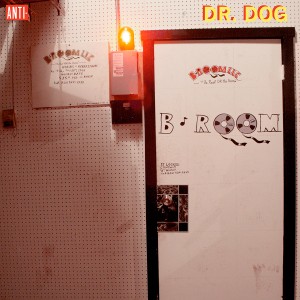Dr. Dog stays the course on latest LP
There is a sentiment amongst critics and fans alike that great bands push their own boundaries, trying with each album to explore new territory. And though there is definitely merit in innovation, with its new album B-Room, Dr. Dog has put together a strong case for sticking with what you know.

Broom cupboard · Neo-psychedelic rock band Dr. Dog had a studio specifically built for the purposes of recording the album B-Room. – Courtesy of ANTI- Records
On the album, the band brings back its signature brand of psychedelic fuzz-folk, full of crooning harmonies that draw instant comparisons to ’60s groups such as The Beach Boys and The Band. What B-Room lacks in ambition, it makes up for with its feel-good tracks.
The sounds and influences might be old, but the Philadelphia outfit decided to build themselves a brand new studio for this latest effort. It tracked everything live in an attempt to give an honest sonic snapshot of the band’s sound.
Artists who make albums around concepts like this run the risk of becoming gimmicky, especially when it names the album after the new studio. Conversations about the upcoming album usually centered around this fact and mentioned little about the actual content. It seemed possible that there might not be much to the album beyond its appeal to the independent listeners who approve of the band’s lack of commercialism.
It only takes a few minutes of listening to realize that this is not the case. If there is one thing that sets Dr. Dog apart from its hipster contemporaries, it’s the refreshing sincerity of the musical delivery. There is absolutely no irony in bassist Toby Leaman’s voice as he delivers the last words of a dying man in “Too Weak To Ramble.” The stripped down ballad consists only of vocals and two guitars and evokes the lo-fi aesthetics of its earlier albums Toothbrush and Passed Away, Vol. 1. And though there are some moments on the album where the band seems steeped in regret and disappointment, these sentiments never come off as bitter or sarcastic.
B-Room borrows from all across the spectrum of Dr. Dog’s previous recordings and styles, from its avant-garde debut Psychedelic Swamp to its more recent high-energy style catered to live performance. Everything was recorded without overdubs; what is heard on the album is supposedly what would be heard in a room with the band and nothing more. This is apparent on tracks such as “The Truth,” which starts out with only a sparse guitar over a driving drum beat. The open-ended quality of this track allows the band to slowly build layers of marimbas, pianos and voices until it reaches a dramatic, anthemic ending.
B-Room is Dr. Dog’s third record with drummer Eric Slick, and it feels like it has figured out how to balance his bombastic style with the band’s understated delivery. Dr. Dog has never made drum-centric music; there is not a single drum solo in its whole discography. Still, there are songs such as the funky “Cuckoo” that show off the chops Slick developed playing in Zappa cover bands before joining Dr. Dog.
Not every song is an up-tempo funk tune; the range of moods is all over the place. The band moves seamlessly from “Twilight” — a song dripping with all the natural imagery of a Wordsworth lyrical ballad — to “Rock n’ Roll,” which uses a rockabilly-like sound to reminisce over the first time the band heard rock ‘n’ roll music as kids. The most memorable moments occur on tracks such as “Love” and “Broken Heart” — lighthearted ruminations on relationships infused with so much ’60s soul that it almost sounds like Motown. The subjects of these songs may be cliché, but the execution is so stellar that the subject matter is forgivable.
It might not be a drastic change of direction from the band’s earlier work, but B-Room does boast far more noticeable jazz, R&B, ska and funk influences. The song “Long Way Down” features Scott McMicken almost rapping his lyrics, with saxophones and trumpets punctuating between each line. The horns section is given much more attention on this track — in fact, there is a breakdown of call-and-response between the horns towards the end of the song that sounds like it was taken straight out of the songbook of fellow Philadelphian outfit The Roots.
It will be interesting to see how the band deals with this change when it goes on tour for the album. Its lineup for live shows typically consists of only the five core members and one person for auxiliary percussion and samples. As a result, the band might be forced to add more to its lineup because many of the songs on B-Room would feel incomplete without the accompanying orchestral instruments.
Some feel that Dr. Dog is wasting its potential to become a more relevant band by staying in its comfort zone. This is easy to say if you’ve only listened to the last few albums. But in reality, the band has come a long way. From its early experimental sound, to the lush, full-bodied soundscapes and arrangements of 2008’s Fate, to today’s bare-bones approach, it has put on a lot of different musical hats while keeping its overall identity as a rock band. Years from now, B-Room might only be seen in Dr. Dog’s timeline as a sign of its current infatuation with the organic. Even so, it will remain as effective then as it is now in its attempt to transport the listener into the middle of the studio floor.
